DPOF printing options PowerShot A460.
| Article ID: ART118772 | | | Date published: 05/12/2015 | | | Date last updated: 08/17/2015 |
Description
Solution
Print Settings (DPOF Print Settings)
You can select images on a memory card for printing and specify the number of print copies in advance using the camera. The settings used on the camera comply with the Digital Print Order Format (DPOF) standards. This is extremely convenient for printing on a direct print compatible printer, or for sending the images to a photo developing service that supports DPOF.
![]()
- The
 mark appears over images that have had print marks set by another DPOF-compliant camera. These settings will be overwritten by any print marks set by your camera.
mark appears over images that have had print marks set by another DPOF-compliant camera. These settings will be overwritten by any print marks set by your camera. - The output of some digital printers or photo lab services may not reflect the specified print settings.
- Print settings cannot be set for movie images.
Selecting Images for Printing
Options for Image Selection.
| Select images and Quantity | Configures print settings for single images as you view them. |
| Select by Date | Configures print settings for images correspoding to the selected date. |
| Select by Folder | Configures print settings for images in the selected folder. |
| Select All Images | Configures print settings for all images. |
| Clear All Selections | Removes all print settings from images. |
![]() Only one copy will be printed for each selected image. With the [Select Images and Qty.] option, you can only set the number of copies to print with the [Print Type] option is set to single print
Only one copy will be printed for each selected image. With the [Select Images and Qty.] option, you can only set the number of copies to print with the [Print Type] option is set to single print ![]() [Standard],
[Standard], ![]() [Index] or
[Index] or ![]() .
.
Procedure for Selecting Images.
1. Slide the mode switch to ![]() (playback) and
(playback) and ![]() and select the
and select the ![]() (Print) Menu
(Print) Menu ![]() Select a Menu item and press the FUNC/SET
Select a Menu item and press the FUNC/SET ![]() button.
button.
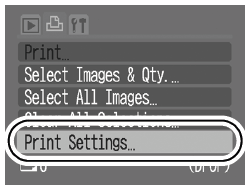
2. Select the Image, date,or folder you wish to print and press the FUNC./SET ![]() button.
button.
- [Select Images and Qty.] The selection methods differ for the Print Type Settings.
- ![]() (Standard) /
(Standard) / ![]() ()
() 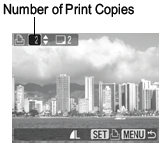
Use the ![]() or
or ![]() button to select an image, press the FUNC./SET
button to select an image, press the FUNC./SET ![]() button and then use the
button and then use the ![]() or
or ![]() button to select the number of print copies ( you can select up to 99 copies).
button to select the number of print copies ( you can select up to 99 copies).
- ![]() (Index)
(Index) 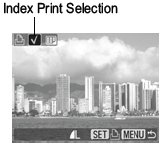
Use the ![]() or
or ![]() button to select the an image and press the FUNC./SET button to select or deselect the image you wish to include in the Index Print.
button to select the an image and press the FUNC./SET button to select or deselect the image you wish to include in the Index Print.
- You can also select images in the index playback mode.
- Press the Menu button to complete the setting.
- [Select by Date], [Select by Folder].
Use the ![]() or
or ![]() button to select a date or folder and press the FUNC./SET button.
button to select a date or folder and press the FUNC./SET button.
- Pressing the FUNC./SET button again cancels the setting.
- You can select multiple dates or folders.
- Use the ![]() or
or ![]() to confirm each date or folder image.
to confirm each date or folder image.
3. For the [Select by Date] and [Select by Folder] options press the <MENU> button.
![]()
4. Select [OK] and press the FUNC./SET button.
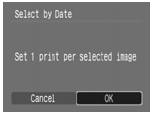
- Selecting [Cancel] cancels print settings of the selected image and returns you to step 1.
![]()
- Images are printed in order from oldest to newest by the shooting date.
- A maximum of 998 images can be marked per SD card.
- If you are connected to a printer, the
 ( Print Share) button will light blue while you are selecting images. You can start printing at this point by pressing the
( Print Share) button will light blue while you are selecting images. You can start printing at this point by pressing the (Print Share) button confirming that [Print] is selected and pressing the FUNC./SET button.
(Print Share) button confirming that [Print] is selected and pressing the FUNC./SET button. - When [Print Type] is set to , the number of copies can be set. When it is set to [Index], the number of copies cannot be set (only one copy will be printed).
- Print settings can also be assigned to images with the supplied software programs on a computer.
Setting the Print Style
The following print settings can be selected.
|
- |
|
Prints one image per page |
|
|
|
Prints index prints (multiple reduced-size images per page) |
|
- |
|
Prints the images in the standard and index formats |
|
|
On/Off |
Adds the date to the print |
|
|
On/Off |
Adds the file number to the print |
| Clear DPOF |
On/Off |
Clears all print settings after the images print. |
1. In the [ ![]() (Replay)] menu, select [
(Replay)] menu, select [![]() (Print)], use the
(Print)], use the ![]() to choose [Print Settings] and press the <FUNC./SET> button.
to choose [Print Settings] and press the <FUNC./SET> button.

2. Select [![]() (Print Type)], [
(Print Type)], [![]() (Date)] or [
(Date)] or [![]() (File No.)] or [Clear DPOF data] and then specify the desired settings. Select a setting using the
(File No.)] or [Clear DPOF data] and then specify the desired settings. Select a setting using the  or
or  button.
button.
5. Press the <MENU> button.
The set up menu will close and the Print Order menu will reappear.
![]() The Date and File No. settings change according to the Print Type as follows.
The Date and File No. settings change according to the Print Type as follows.
- Index
[Date] and [File No.] cannot be set to [On] at the same time.
- Standard or
[Date] and [File No.] can be set to [On] at the same time, however, the printable information may vary between printers.
- The date prints as the date and time in the format specified in the Set Date/Time menu. Images with date imprints created by (Postcard Date Imprint Mode) (p. 35) will have the date imprinted regardless of the [Date] setting. Accordingly, the date may be printed twice if [Date] is set to [On].
- Dates print in the style specified in the [Date/Time] menu.
Setting the DPOF Transfer Settings
You can use the camera to specify settings for images before downloading to a computer. The settings used by the camera comply with the Digital Print Order Format (DPOF) standards.
| The |
Single Images
1.![]() (Play) Menu
(Play) Menu ![]() and choose the
and choose the ![]() (Transfer Order) option from the menu.
(Transfer Order) option from the menu.
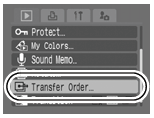
2. Select [Order] and press FUNC./SET.

- Selecting [Reset] cancels all transfer order settings.
3. Use the ![]() or
or ![]() button to select an Image to transfer and press FUNC./SET.
button to select an Image to transfer and press FUNC./SET.
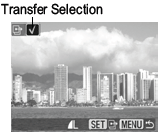
- Pressing the FUNC./SET button again deselects the setting.
- You can also select images in the index playback mode.
All the images on the Memory Card.
1.![]() (Play) Menu
(Play) Menu ![]() and choose the
and choose the ![]() (Transfer Order) option from the menu.
(Transfer Order) option from the menu.

2. Select [Mark all] and press FUNC./SET.
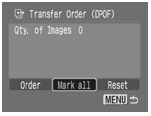
3. Select [OK] and press FUNC./SET.
![]()
- Images are transferred in order according to the file number.
- A maximum of 998 images can be selected.
